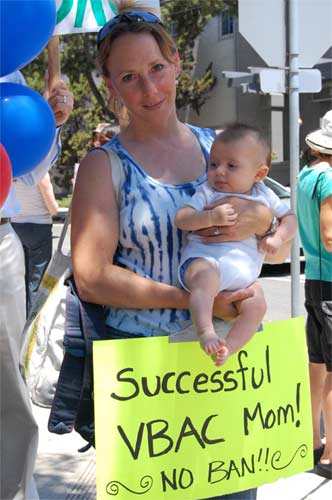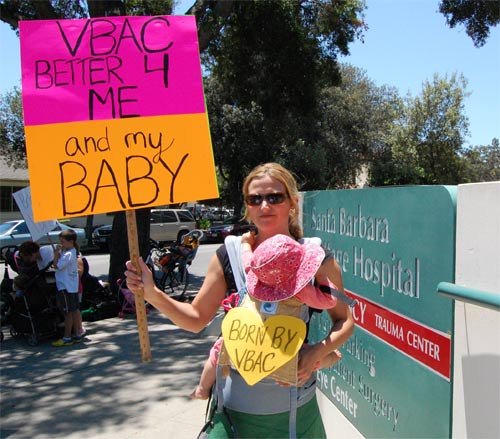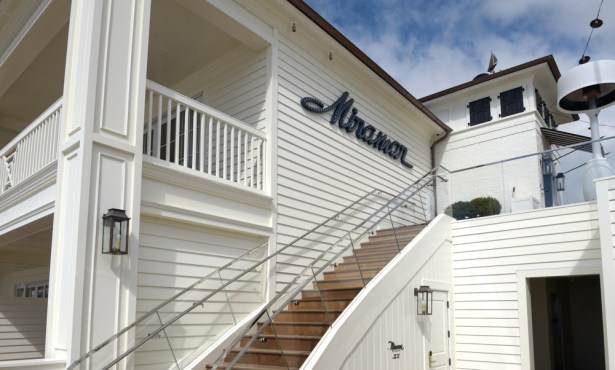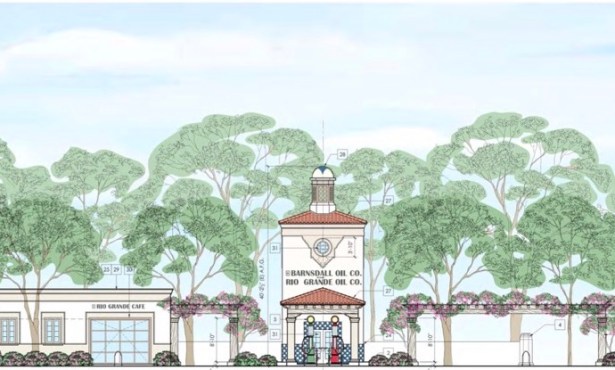Families Protest Outside Cottage Hospital
Say Mothers Should Be Allowed "Natural Childbirth" Regardless of Previous C-Sections

Protesters outside Cottage Hospital on Monday morning held their babies along with their signs. Objecting to area obstetricians’ choice to prohibit natural childbirth procedures for women who have had a cesarean section, or Vaginal Birth After Cesarean (VBAC), most of the women and men aimed to inform passersby of their plight and to ultimately grant expectant mothers the choice to deliver their babies naturally regardless of previous birthing procedures they may have undergone. It’s been four years since Santa Barbara obstetricians began following this guideline.
Amara Maliszewski explained that for many women, it is devastating news “when someone tells you [that] you can never experience this awesome natural miracle.” Maliszewski said she felt lucky to have delivered her “VBAC baby,” Lucinda, at home with a midwife. She also said that many doctors do not recommend women to have more than two or three cesareans in their lifetime; and with American College of Obstetricians and Gynecologists’ (ACOG) recommendation to obstetricians to deliver babies via cesarean sections, women are consequently limited as to the amount of children they are able to have, protestors said. “This is a civil rights issue to birth your child the way that you want,” said Adela Barcia, a psychotherapist specializing in prenatal and perinatal health and psychology. Barcia has experience with the evidence that the method of birth affects the psychological and physical health of the baby and mother and said she works with “many women who have profound grief about the issue.”

Doctors told Abraham and Jessica Powell that she had a .5 percent of a chance of uterine rupture after VBAC. Uterine rupture is the most commonly cited risk with VBAC, when the uterus tears during delivery, requiring the delivery to be switched to a cesarean. According to ACOG, the switch causes an increased risk of infection to both the baby and mother. “Finally, what it comes down to is a question of choice,” said Jessica Powell. After she went into labor, she had to drive to UCLA where VBAC is standard procedure. “It seems crazy and it is.”
Indeed, driving to UCLA as the Powells did seems to be one of the options for women wanting to birth their children vaginally. But the requisite multiple prenatal checkups in Los Angeles, not to mention the two-hour drive while in labor, some may call this “completely impractical” and “nearly impossible.” Even so, the Powells decided this was the best way for their family, and they are glad they did so. Their second child was born with no complications.
Protestor Carrie Bluth explained that she found an obstetrician at Ventura Community Memorial who was very sympathetic towards her. When asked how she delivered VBAC, she answered simply, “I asserted my rights.” She refused to have the surgery when she arrived at the hospital late in her labor, and immediately said she did not want a cesarean.
Although the widely-accepted terms for this debate are “ban” and “hospital policy,” Janet O’Neill, Cottage Hospital Spokesperson and Director of Public Affairs, explained that this decision is absolutely independent of Cottage Hospital’s standard guidelines, however. She says this decision was made after a recommendation from the ACOG to the doctors in Obstetrics & Gynecology.
Dr. Robert Reid, MD, Director of Medical Affairs at Santa Barbara Cottage Hospital, emphasized the need for a standard of procedure at Cottage when it comes to this debate. He said he recognized the reason for ACOG’s recommendation and understands the safety and liability issues. In order for VBAC to be safe, an emergency surgical staff needs to be immediately available; this is why larger teaching medical centers such as UCLA and Sierra Vista in San Luis Obispo offer VBACs while Santa Barbara facilities do not.
Jessica Barton, the organizer of the protest, said she hopes that obstetricians in Santa Barbara will be practicing VBAC again soon. Barton continued that it doesn’t matter if the hospital calls it a ban or policy. “Women are experiencing a lack of access to VBAC in our community,” she said, noting that a big challenge for new mothers after having a cesarean is the extensive recovery period. After her own cesarean, Barton says the first few days she was hardly able to pick up her new baby, which made it difficult to breastfeed. “It was 12 weeks before I felt like my real self again,” she says; it’s for this reason that she is fighting for the option of VBAC rather than going through major surgery again.
Currently, Barton and her fellow protesters from Birth Action Coalition are working to raise awareness in the community; they are also writing letters and pressuring the hospital to allow VBACs once again. Another rally is planned to take place in Ventura.



